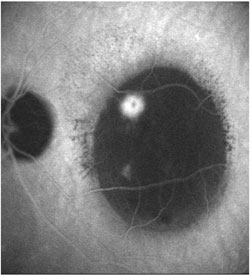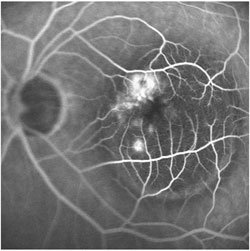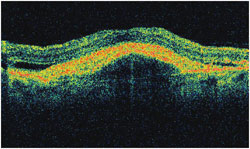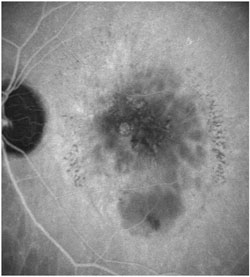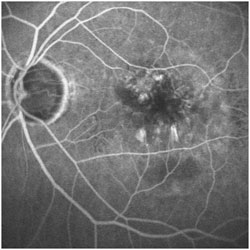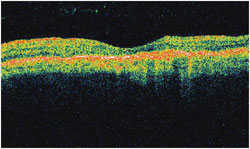Intravitreal anti-VEGF therapy shows efficacy in treating retinal angiomatous proliferation
A study found better results with use of ranibizumab over bevacizumab.
PARIS — Intravitreal anti-VEGF injection is a feasible treatment option in patients with retinal angiomatous proliferation. Ranibizumab is more effective than bevacizumab in advanced stages of the disease involving pigment epithelium detachment, according to a study presented at the meeting of the French Society of Ophthalmology.
Retinal angiomatous proliferation is a distinct form of neovascular age-related macular degeneration with high vasogenic potential and unknown origins.
“It might originate from a retinal or choroidal lesion, or from both sites at the same time. Whatever the origin, the most important feature is the formation of type 3 retinal and choroidal new vessels. The prognosis is poor. Bilateral involvement approaches 100% within 3 years,” Francesco Bandello, MD, FEBO, said.
Retinal angiomatous proliferation pathophysiology involves ischemic and inflammatory components. Positive immunoreactivity to VEGF and macrophage migration were shown in studies by Shimada in 2007 and Monson in 2008.
“This is the rationale for treating [retinal angiomatous proliferation] with anti-VEGF therapy,” Dr. Bandello said.
Carried out in the university clinics of Udine and Trieste, Italy, the prospective, comparative, randomized study aimed to compare intravitreal injection with Avastin (bevacizumab, Genentech) and Lucentis (ranibizumab, Genentech). The follow-up period was 12 months.
|
|
|
|
|
ICG angiography, fluorescein angiography and
OCT show the characteristic appearance of retinal angiomatous proliferation
before the treatment. |
||
|
|
|
|
|
After the treatment with anti-VEGF
injections, a recovery of the normal macular profile is visible.
Images: Bandello F |
||
Patients with a diagnosis of retinal angiomatous proliferation who had not received any previous treatment and had no other ocular disease were included.
“We monitored the changes in best corrected visual acuity by ETDRS charts, as well as the changes in central macular thickness measured by OCT,” Dr. Bandello said.
The treatment schedule consisted of a loading phase with three injections in the first 3 months, followed by monthly evaluation with repeated treatment whenever fluids on OCT, new hemorrhages on biomicroscopic fundus examination or persistent leakage on fluorescein angiography were detected.
A total of 50 patients were enrolled; 26 were randomized to receive intravitreal injection of bevacizumab, and 24 received ranibizumab. Fourteen patients in the bevacizumab group were in stage 1 of the disease and 12 were in stage 2. In the ranibizumab group, 14 were stage 1 and 10 were stage 2.
“A significant improvement of visual acuity was observed at all stages of the follow-up. More than one-third of the patients gained more than three lines. At a first glance, the results of the two groups did not show any difference,” Dr. Bandello said. However, five patients lost one line in visual acuity in the bevacizumab group, compared with two patients in the ranibizumab group.
Central macular thickness was also significantly reduced in both groups, with a slight difference in favor of the ranibizumab group.
“All patients showed a reduction in [central macular thickness]. Patients in the ranibizumab group had a slightly higher mean [central macular thickness] of 354 µm at baseline. Improvement was significant, leading to a mean [central macular thickness] of 208 µm at 12 months. Improvement with bevacizumab was also significant, but within a smaller range, from 309 µm at baseline to 220 µm at endpoint,” Dr. Bandello said.
Retinal pigment epithelium detachment was present in some of the eyes with stage 2 retinal angiomatous proliferation. In this subgroup of patients, the efficacy of the two agents showed significant differences, he said.
“[Pigment epithelium detachment] rapidly reverted in nine of 10 patients of the ranibizumab group, while seven of 12 patients in the bevacizumab group still showed signs of [pigment epithelium detachment] at 1 year. The presence of [pigment epithelium detachment] was a parameter to show the difference between the two agents,” Dr. Bandello said.
A larger clinical trial, he said, is necessary to assess the effectiveness of the anti-VEGF approach for retinal angiomatous proliferation. – by Michela Cimberle
References:
- Monson DM, Smith JR, Klein ML, Wilson DJ. Clinicopathologic correlation of retinal angiomatous proliferation. Arch Ophthalmol. 2008;126(12):1664-1668.
- Shimada H, Kawamura A, Mori R, Yuzawa M. Clinicopathological findings of retinal angiomatous proliferation. Graefes Arch Clin Exp Ophthalmol. 2007;245(2):295-300.
- Francesco Bandello, MD, FEBO, can be reached at Fondazione San Raffaele del Monte Tabor, Clinica Oculistica, Via Olgettina, 60, 20132 Milan, Italy; 39-02-26433598; fax: 39-02-26433643; e-mail: bandello.francesco@hsr.it.

